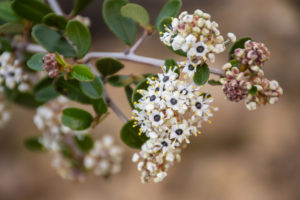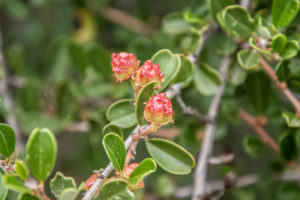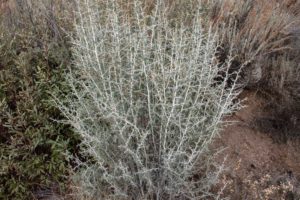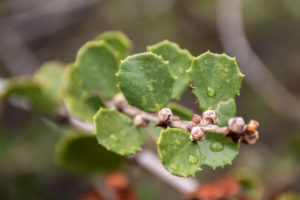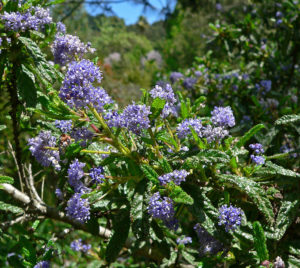Ceanothus is perhaps the chaparral’s most defining group of shrubs. Several species of ceanothus, or California lilac as they’re frequently called, can be found throughout the Los Padres National Forest. These plants are part of the buckthorn family and are related to other common chaparral species such as spiny redberry and coffeeberry.
Most ceanothus are below 12 feet tall and have either white or blue flowers. Similar to other chaparral shrubs, plants within a single species can vary in appearance depending on location and other conditions. Interestingly, California lilacs are well-known to hybridize, meaning that you may encounter a plant that looks like a blend of more than one species.
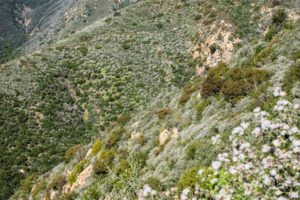
Ceanothus blooming in late January gives beautiful texture and color to the chaparral in the Santa Ynez Mountains.
Many ceanothus flowers will make a soapy lather when crushed in the hand with water. This was one of the several uses the Chumash and other indigenous peoples had for ceanothus. They also used tea brewed from the leaves of some species to treat coughs and colds. The wood of other species was used for a variety of items, including fence posts, digging sticks, and wedges for splitting canoe planks. More about how the Chumash used these and other chaparral plants can be found in the excellent book, Chumash Ethnobotany by Jan Timbrook.
Approximately 80% of ceanothus species are obligate seeders (also known as nonsprouters) meaning they are unable to resprout from a burl or their roots following a wildfire. The seeds of these particular species are fire-dependent and need a fire cue such as heat shock or chemicals from smoke or charred wood in the soil to germinate. Because they are typically obligate seeders, ceanothus are susceptible to increased fire frequency in the chaparral. Some species have been documented as becoming locally extinct after several fires in the same area over a short period (less than 20 years between each fire). You can read more about this issue on our fire page.
There are 55 species of ceanothus in California and approximately 21 of them can be found in the Los Padres National Forest:
| Scientific Name | Common Name | Rarity Status |
|---|---|---|
| Ceanothus arboreus | Island ceanothus | |
| Ceanothus cordulatus | Snow bush | |
| Ceanothus crassifolius | Hoary leaved ceanothus | |
| Ceanothus cuneatus | Buck brush | |
| Ceanothus dentatus | Dwarf ceanothus | |
| Ceanothus foliosus | Wavy leaved ceanothus | |
| Ceanothus greggii | Desert ceanothus | |
| Ceanothus vestitus | Mojave ceanothus | |
| Ceanothus perplexans | Cupped leaf ceanothus | |
| Ceanothus impressus | Santa Barbara ceanothus | |
| Ceanothus incanus | Coast whitethorn | |
| Ceanothus integerrimus | Deer brush | |
| Ceanothus leucodermis | Chaparral whitethorn | |
| Ceanothus maritimus | San Luis Obispo ceanothus | Rare Plant Rank 1B.2 (CNPS) |
| Ceanothus megacarpus | Bigpod ceanothus | |
| Ceanothus oliganthus | Hairy ceanothus | |
| Ceanothus palmeri | Palmer's ceanothus | |
| Ceanothus papillosus | Wartleaf ceanothus | |
| Ceanothus rigidus | Monterey ceanothus | Rare Plant Rank 4.2 (CNPS) |
| Ceanothus spinosus | Greenbark ceanothus | |
| Ceanothus thyrsiflorus | Blueblossom |
Five of these species are particularly common in the Los Padres depending on the location. These species are described in more detail below.
Bigpod Ceanothus
Ceanothus megacarpus
A common species of ceanothus found throughout the Santa Barbara frontcountry, this plant is named for its large seedpods (fruits) compared to other ceanothus species. It’s leaves typically have smooth margins and are alternately arranged on the stem. Be on the lookout for spectacular displays of bigpod ceanothus blooms in the Santa Ynez Mountains from late January to April.
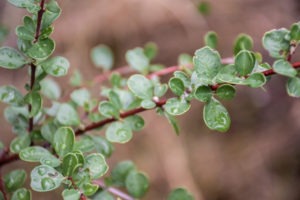 Buck Brush
Buck Brush
Ceanothus cuneatus
Found in nearly every county of the state, buck brush is the most widespread species of ceanothus in California, and is one of the dominant plants found in chaparral ecosystems. It is similar in appearance to bigpod ceanothus, a major difference being its oppositely-arranged leaves. Like its cousin described above, buck brush can make hills and mountainsides come alive with white blossoms in the late winter and early spring.
Chaparral Whitethorn
Ceanothus leucodermis
While bigpod and greenbark ceanothus are typically found close to the coast, chaparral whitethorn tends to dominate chaparral in the drier inland mountains of the southern Los Padres National Forest. Its white, sharp branches and blue-green leaves are unmistakable—especially if you’re trying to walk through a stand. Its leaves are also alternately-arranged and have wide-toothed margins. Look for whitethorn blooms from March to May in the backcountry.
Hoary Leaved Ceanothus
Ceanothus crassifolius
Hoary leaved ceanothus is common in the Santa Barbara frontcountry and the Ojai backcountry of the Los Padres. Unlike most other ceanothus species in the region, it has leathery leaves that tend to curl around the center vein. Its leaves are opposite and have vaguely-toothed margin in addition to having distinct front and back sides.
Wartleaf Ceanothus
Ceanothus papillosus
This species of ceanothus is common to the Big Sur region of the Los Padres National Forest. It is named for its distinctive oblong leaves that are covered in glandular bumps (“warts”). It can be found along the coastal areas of the Santa Lucia Mountains, where you can see its blue flowers on display in April and May.
All photos by Bryant Baker unless otherwise noted.

